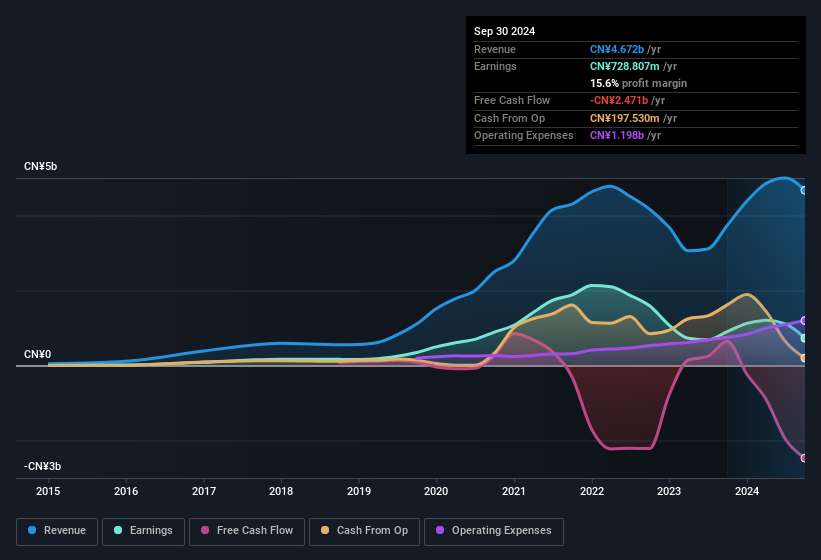Investors were disappointed by Maxscend Microelectronics Company Limited's (SZSE:300782 ) latest earnings release. We did some further digging and think they have a few more reasons to be concerned beyond the statutory profit.

Zooming In On Maxscend Microelectronics' Earnings
One key financial ratio used to measure how well a company converts its profit to free cash flow (FCF) is the accrual ratio. To get the accrual ratio we first subtract FCF from profit for a period, and then divide that number by the average operating assets for the period. The ratio shows us how much a company's profit exceeds its FCF.
That means a negative accrual ratio is a good thing, because it shows that the company is bringing in more free cash flow than its profit would suggest. While it's not a problem to have a positive accrual ratio, indicating a certain level of non-cash profits, a high accrual ratio is arguably a bad thing, because it indicates paper profits are not matched by cash flow. Notably, there is some academic evidence that suggests that a high accrual ratio is a bad sign for near-term profits, generally speaking.
 Over the twelve months to September 2024, Maxscend Microelectronics recorded an accrual ratio of 0.33. We can therefore deduce that its free cash flow fell well short of covering its statutory profit, suggesting we might want to think twice before putting a lot of weight on the latter. Even though it reported a profit of CN¥728.8m, a look at free cash flow indicates it actually burnt through CN¥2.5b in the last year. We saw that FCF was CN¥644m a year ago though, so Maxscend Microelectronics has at least been able to generate positive FCF in the past. Having said that, there is more to the story. We can see that unusual items have impacted its statutory profit, and therefore the accrual ratio.
Over the twelve months to September 2024, Maxscend Microelectronics recorded an accrual ratio of 0.33. We can therefore deduce that its free cash flow fell well short of covering its statutory profit, suggesting we might want to think twice before putting a lot of weight on the latter. Even though it reported a profit of CN¥728.8m, a look at free cash flow indicates it actually burnt through CN¥2.5b in the last year. We saw that FCF was CN¥644m a year ago though, so Maxscend Microelectronics has at least been able to generate positive FCF in the past. Having said that, there is more to the story. We can see that unusual items have impacted its statutory profit, and therefore the accrual ratio.
That might leave you wondering what analysts are forecasting in terms of future profitability. Luckily, you can click here to see an interactive graph depicting future profitability, based on their estimates.
How Do Unusual Items Influence Profit?
The fact that the company had unusual items boosting profit by CN¥59m, in the last year, probably goes some way to explain why its accrual ratio was so weak. While we like to see profit increases, we tend to be a little more cautious when unusual items have made a big contribution. We ran the numbers on most publicly listed companies worldwide, and it's very common for unusual items to be once-off in nature. And, after all, that's exactly what the accounting terminology implies. If Maxscend Microelectronics doesn't see that contribution repeat, then all else being equal we'd expect its profit to drop over the current year.
Our Take On Maxscend Microelectronics' Profit Performance
Maxscend Microelectronics had a weak accrual ratio, but its profit did receive a boost from unusual items. Considering all this we'd argue Maxscend Microelectronics' profits probably give an overly generous impression of its sustainable level of profitability. Keep in mind, when it comes to analysing a stock it's worth noting the risks involved. Be aware that Maxscend Microelectronics is showing 3 warning signs in our investment analysis and 2 of those are significant...
Our examination of Maxscend Microelectronics has focussed on certain factors that can make its earnings look better than they are. And, on that basis, we are somewhat skeptical. But there is always more to discover if you are capable of focussing your mind on minutiae. For example, many people consider a high return on equity as an indication of favorable business economics, while others like to 'follow the money' and search out stocks that insiders are buying. So you may wish to see this free collection of companies boasting high return on equity, or this list of stocks with high insider ownership.
Have feedback on this article? Concerned about the content? Get in touch with us directly. Alternatively, email editorial-team (at) simplywallst.com.
This article by Simply Wall St is general in nature. We provide commentary based on historical data and analyst forecasts only using an unbiased methodology and our articles are not intended to be financial advice. It does not constitute a recommendation to buy or sell any stock, and does not take account of your objectives, or your financial situation. We aim to bring you long-term focused analysis driven by fundamental data. Note that our analysis may not factor in the latest price-sensitive company announcements or qualitative material. Simply Wall St has no position in any stocks mentioned.

